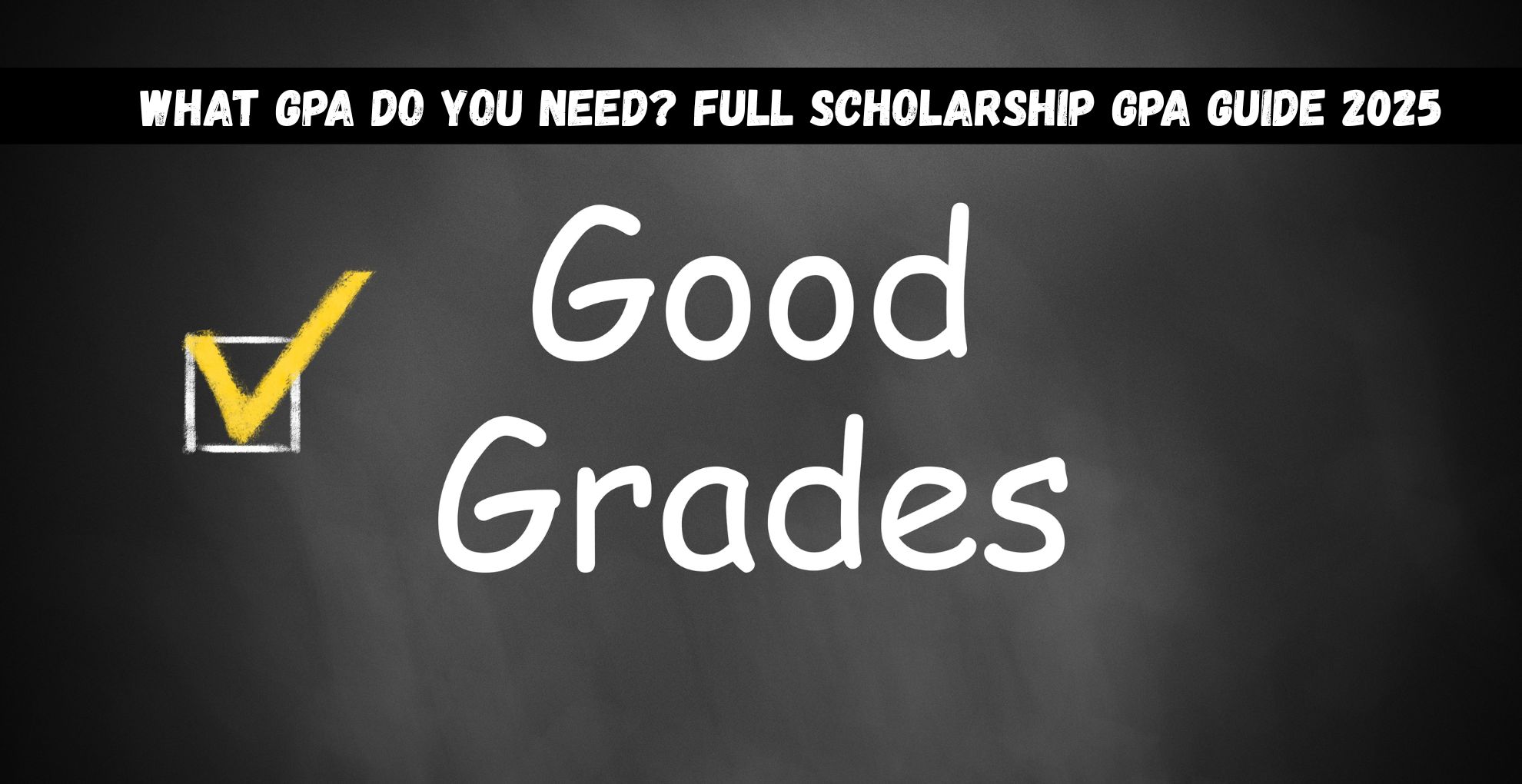Earning a full scholarship is a dream for many students and their families. It’s more than just a financial win—it’s a doorway to opportunity, allowing you to focus on learning and growing instead of stressing over tuition bills. But one of the biggest questions on every student’s mind is: What GPA do you need to get a full scholarship in 2025? The answer isn’t as cut and dry as a single number. It depends on the type of scholarship, the awarding institution, and—believe it or not—your overall story as a student.
In this article, we’ll unpack everything you need to know about the full scholarship GPA landscape in 2025, give you actionable tips to boost your chances, and help you understand what truly makes an application stand out.
GPA Isn’t Everything—But It Sure Helps
Grades matter. A lot. A high GPA signals to scholarship committees that you’re serious about academics and capable of handling college-level work. But while GPA is a key factor in many full scholarship decisions, it’s rarely the only one.
The truth is, there’s no universal GPA requirement for a full ride. Some providers may explicitly list a GPA cutoff, while others evaluate academic records in context with extracurricular achievements, financial need, or leadership skills. In 2025, scholarship committees are leaning more and more into holistic review—looking at the whole person, not just their report card.
Still, let’s break down what GPAs typically put you in the running for a full scholarship.

What GPA Do You Need?
4.0 GPA: The Golden Ticket
If you’re rocking a 4.0, congratulations—you’re in excellent shape. A full scholarship GPA doesn’t get more solid than this. A perfect GPA signals consistent academic excellence and can make you a top contender for competitive national awards like the National Merit Scholarship or university-specific full-ride offers.
But beware: not all 4.0s are viewed equally. Scholarship committees often look at the rigor of your coursework. Did you challenge yourself with AP, IB, or honors classes? Did you push boundaries or just play it safe?
3.8–3.9 GPA: Still Extremely Competitive
If you’re in this range, you’re likely outperforming most of your peers. Many full-ride scholarships fall within this GPA expectation. But to shine, you’ll want to supplement your grades with evidence of strong leadership, extracurricular involvement, or community service.
3.5 GPA: Strong, But You’ll Need More
A 3.5 GPA can still be competitive, especially for merit-based or need-based scholarships that consider other aspects of a student’s profile. If your GPA falls here, make sure the rest of your application tells a compelling story. Highlight your unique strengths, like a passion for service, a creative project, or overcoming adversity.
3.0–3.4 GPA: Possible With a Powerful Application
A GPA in the low 3s isn’t a dead end. Many students win full funding through athletic, arts, or special interest scholarships. You may also qualify for need-based aid or smaller scholarships that, when combined, can cover your college costs.
How to Boost (and Maintain) a High GPA
Improving your GPA takes time, effort, and smart planning. Whether you’re a freshman looking to build momentum or a junior working to raise your average, here are a few proven strategies:
- Prioritize core academic subjects. Focus on getting solid grades in math, science, English, and history.
- Choose your classes strategically. Honors and AP classes can boost your weighted GPA and demonstrate academic rigor.
- Ask for help early. Don’t wait until you’re falling behind. Tutors, teachers, and counselors are there to support you.
- Stay organized. Use planners or apps to track deadlines and avoid late assignments.
- Take care of your mental health. Stress and burnout can derail even the best academic plans. Don’t be afraid to take breaks and set boundaries.
Maintaining a high GPA also means staying consistent. Show up, do the work, and stay focused on your goals—especially during senior year when motivation can start to fade.
What Else Makes You Scholarship-Worthy?
A great GPA opens doors—but it’s what you do beyond the classroom that gets you through them.
Stand Out with a Strong Profile
Colleges and scholarship committees in 2025 are looking for students who bring more than just good grades to the table. They want curious, engaged, and well-rounded individuals who will make an impact on campus and beyond.
Here’s how to boost your scholarship potential:
- Get involved. Join clubs, sports, or student government. Passion projects matter.
- Volunteer. Commit to causes you care about. Community impact can weigh heavily in applications.
- Pursue leadership roles. Start a club, lead a campaign, mentor younger students. Show you can take initiative.
- Build relationships. Strong recommendation letters from teachers or mentors who truly know you can tip the scale.
One student with a 3.6 GPA won a full ride after writing an unforgettable essay about tutoring ESL students in their community and founding a language club to bridge cultural gaps at school. That kind of initiative doesn’t show up in a transcript, but it matters.

Where to Find Full Scholarships
Not all full scholarships are created equal, and not all are widely advertised. Here’s where you should be looking:
- University websites. Many schools offer full-ride or full-tuition scholarships for top students.
- Platforms like Bold.org or Fastweb. These sites aggregate thousands of scholarship opportunities.
- State-specific programs. Your local government or public university system may have scholarships targeting residents.
- Niche awards. There are scholarships for almost every background, career goal, and hobby—from STEM to storytelling.
- QS ImpACT scholarships. These are global opportunities for students committed to academic excellence and positive social change.
When applying, always read the criteria carefully. Some may require a certain full scholarship GPA, while others focus on community impact or leadership. Create a spreadsheet to track deadlines, required materials, and status updates.
Writing a Scholarship-Winning Essay
Your essay is where you connect emotionally with the reviewer. It’s your chance to go beyond GPA and test scores and tell your story.
Be personal, not generic. Share what drives you. Be honest about your challenges, your growth, and your aspirations. Avoid clichés and try to reflect deeply on what education means to you and how you plan to use it.
And of course—proofread. Typos and grammar mistakes can undermine even the most heartfelt essay.

Frequently Asked Questions (FAQs)
What GPA do I need to get a full scholarship?
It varies by scholarship, but many full-ride opportunities start at a 3.5 GPA or higher. Some elite scholarships may require a 3.8 or 4.0, while others may look more holistically at your application.
Is a 3.0 GPA good enough for a full scholarship?
It can be, especially for need-based, athletic, or special talent scholarships. You’ll need to make up for the lower GPA with strong extracurriculars or a compelling story.
Do I need a weighted or unweighted GPA?
Both may be considered. Weighted GPAs account for course difficulty (like AP or honors), which can give you an edge in competitive scholarships.
Can international students get full scholarships?
Yes! Many universities offer full scholarships to top-performing international students, though they are highly competitive. Highlight your unique global perspective and achievements.
Can I combine smaller scholarships to create a full ride?
Absolutely. If you don’t get one big scholarship, stacking several smaller ones can cover just as much.
Final Thoughts: GPA Opens the Door, But You Walk Through It
The search for a full scholarship GPA isn’t about hitting a magic number. It’s about showing scholarship committees that you’re committed, capable, and ready to make an impact.
If you have a 4.0, fantastic—use it as your launchpad. If your GPA isn’t perfect, don’t panic. Focus on telling your story, highlighting your strengths, and applying broadly.
Because in 2025, full scholarships aren’t just awarded to the “perfect” student. They’re awarded to the persistent ones—the students who show up, stand out, and make their mark.
So aim high, stay grounded, and never stop believing in your potential. Your dream college—and that full scholarship—might be closer than you think.




